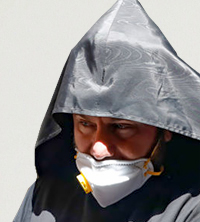
From 249 to 262 AD, one of the most terrible pandemics in history broke out in the Roman Empire. The source of the plague is still unknown, but according to the documents of that time, about 5,000 people died every day in Rome alone. It should be noted that due to the pandemic, the Sasanians were able to conquer the most powerful ally of Rome in the East, Armenia.
Both in Armenia and around the world, there is some tension between Christian figures and secular authorities over restrictions on joint prayers and other ceremonies. Experts’ suggestions are contradicting the rules of church life. This contradiction goes back to early Christianity.
The early Christian church opposed the Roman secular authorities and pagan beliefs, that is, the official ideology.
According to both Christian and non-Christian sources, the main reason for the growing influence of the Church in the beginning was the difference in the reactions of Christians and heathens to existential problems. Christians had meaningful answers to the eternal questions of sickness, suffering, and death, which were the vital issues of the day.
From 249 to 262 AD, one of the most terrible pandemics in history broke out in the Roman Empire. The source of the plague is still unknown, but according to the documents of that time, about 5,000 people died every day in Rome alone. It should be noted that due to the pandemic, the Sasanians were able to conquer the most powerful ally of Rome in the East, Armenia.
One of the witnesses, Bishop Dionysius of Alexandria, wrote that although the plague did not distinguish between Christians and non-Christians, “the weight of its influence fell on non-Christians,” meaning that the latter did not engage in worthy moral conduct. According to him, the heathens, “at the first sign of the disease, drove the sufferers away from them, ran away even from their relatives, leaving them to die, treating the corpses on the roads like decaying things, thus hoping to prevent the spread of a deadly disease. But even when they did their best, it was difficult to avoid the disease. ”
It is not difficult to notice the negative attitude of the Christian author towards the security measures offered by pagan science.
In a detailed description of the behavior of Christians during the plague in Alexandria, Bishop Dionysius writes that “the best of them” selflessly served the sick until they fell ill and died. “Many of our Christian brothers have shown boundless love and loyalty, not sparing themselves and thinking only of their loved ones. Ignoring the danger, they became responsible for the sick, taking care of the needs of each of them and thus serving Christ. They left life happily with these patients, taking on the illness of their loved ones and happily sharing their pain.” Although their behavior did not help prevent the pandemic at all, perhaps even contributing to the spread of the plague, their high moral values contributed to the spread of Christianity in the second half of the third century.
However, the plague in Europe in 1346-1353 had completely different consequences for the church.
The epidemic gave rise to religious hysteria, which many interpreted as God’s punishment. Mass marches with self-immolation became commonplace, and the clergy covered the cities with blessed threads. The papal temporary center, which was then moved from Rome to the French city of Avignon, came to terms with the existence of thousands of superstitious sects, as it was unable to resist the medieval infodemic.
It should be noted that many clergymen were truly self-sacrificing, following the example of the early Christians, sacrificing themselves in caring for the sick. The church lost its best clergymen during the plague, and was replaced by mostly ignorant ones, who blamed Jews and witches for the epidemic. At that time, Europe was divided into two parties: the Guelphs and the Ghibellines, the supporters of the Pope and secular power. The secular government felt the weakness of the Catholic Church and was able to strengthen its primacy.
Unlike the church, the secular authorities were more effective, for example, in organizing “sanitary battalions.” As of now, during the coronavirus epidemic, Italian cities in Europe have suffered the most, and the authorities have responded quickly to the threat.
Special detachments were set up to take out the bodies and bury them, the first quarantines were set up to detect the infected city visitors and a 40-day isolation in urban areas was imposed, which was first to be used in Venice, as well as the infirmary system was established — special hospitals for the treatment of patients, and so on.
For the first time, secular authorities were able to prove that they could be more effective than the Catholic Church. It was the victory of the secular authorities over the supremacy of the Vatican. The role of literature and art began to grow, which was mostly secular, because creative freedom tried to shake off the yoke of religious dogmas. It gave a boost to the Renaissance.
The strengthening of secular power laid the foundation for the idea of a sovereign nation-state, which is the main characteristic of the New Age.
How will these changes affect the Christian churches? Many religious leaders and theologians do not yet have the answer.